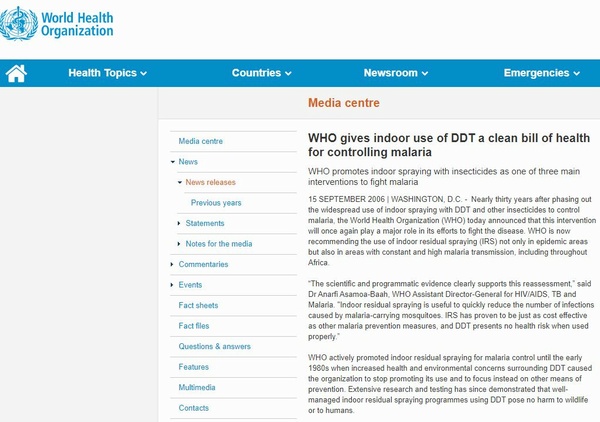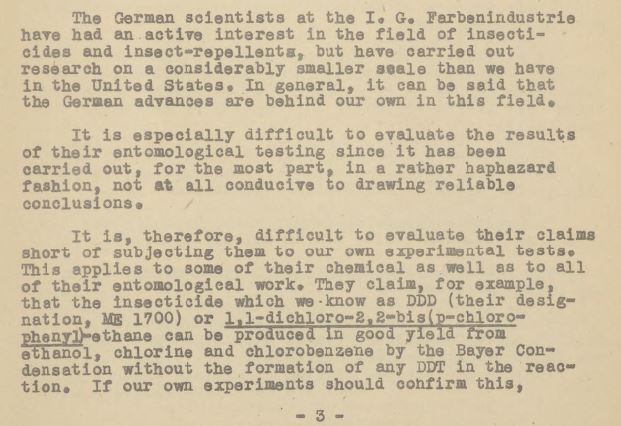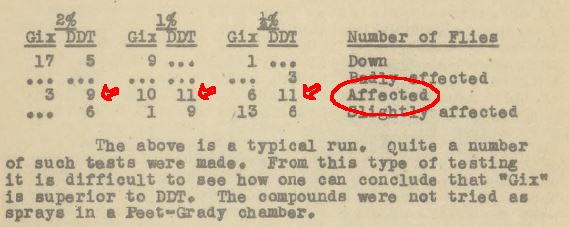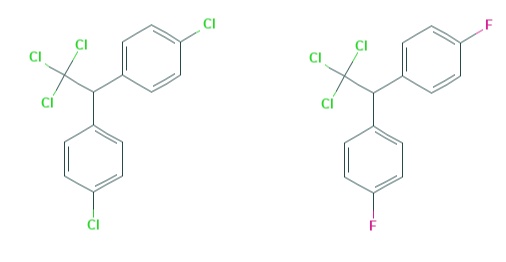In the latter half of World War II, the Germans were desperate to stop the Allied invasion to take back Europe. The first theater wasn't Normandy in June of 1944, it was Italy in 1943. To slow down the Americans, Brits, and Canadians in Naples they wrecked the already inadequate infrastructure, knowing that would lead to disease and therefore casualties. It did - and that led to a great scientific debut.
To prevent a typhus pandemic, a million Italians were dusted by the then also recently rediscovered(3) compound DDT, and it removed the lice that caused typhus.
From there, DDT took the world by storm, even malaria was on the verge of being wiped out - and then Rachel Carson's publisher-commissioned polemic "Silent Spring" promoted concern that thinner bird shells in mass-sprayed areas would mean future harm(4), and the United Nations stopped using it. For a time.

But in the 1940s DDT was not the only modern insecticide being investigated - the Nazis had their own research as well. Yet unlike Wernher von Braun and other scientists on the rocket side, the U.S. had little confidence in DFDT scholarship because Nazi chemists were not big on rigorous trials. They did some tests with flies using contact results on coated paper and then sprayed it in Russia and Africa and it did seem to kill bugs so that was good enough. But they never did tests of it as a spray.
Americans who interviewed the German scientists about their work were unimpressed.

Even DFDT was not the only other compound in testing, the race was on in numerous companies to propel public health into the future. There was also DDD, Bladan, AL-63 in England, etc. but DDT won out over Gix because of the combination of cost, efficacy, and lower toxicity. That's right, lower toxicity.

Prior to World War II, Italy had a nominal few dozen or so cases of typhus per year, primarily from immigrants. Then suddenly in Naples alone, where a million people in a war-torn country lived, there sprang up 300 cases in just December of 1943. That's a pandemic about to happen. (5)
The United States of America Typhus Commission mobilized quickly but knew they were going to be spraying civilians in a country with poor sanitation that had been ravaged by battles between occupiers and rescuers. They wanted lice gone from human bodies, but not to create toxic clouds that also led to dead animals and people. For carpet bombing, sure go with the most toxic poison, but when you "don't know what you don't know" about human and animal toxicity - during war, as developments happen in real time - you go with the safest effective product, especially since German insecticide chemists had done such shoddy experiments on DFDT. And that was DDT. In just a few years it had lots of safety studies and had been shown to work.

Taken at Anzio. Knowing the Nazis were going to counter-attack to secure the beachhead again, 22,000 civilians were evacuated to Naples, which kept them out of military harm but increased disease risk. Between January and May of 1944, America had over 33,000 casualties in Italy - over 18,000 of those were disease.
With just an ounce of DDT per person using 40 delousing stations, the crisis faded after a one-month program treated a million people. That was a fantastic public health win.
DDT was hailed as a miracle product, Müller won the 1948 Nobel Prize in Medicine, while DFDT was left to history like many other Nazi programs.
In their recent paper, the authors argue DFDT was better, but that is a bit like arguing that HD DVD was better than Blu-ray or that Stuart Townsend was a better "Lord of the Rings" casting choice for Aragorn than Viggo Mortensen. Things don't work that way.
With a million people at risk, American scientists didn't want to do a bunch of new studies to try and validate work by Germans who came up with their product to get out of paying royalties on DDT and were only using their products in places where they believed people were "sub-human."
After the war, DFDT would have cost a lot more to produce and no one wanted an "imitator" of the famous thing, especially not with the Nazi stigma when we had just sent 2,000,000 Americans over there to defeat them. They wanted DDT. (6)
But it's been 75 years since DDT took the world by storm, and that means it's a good time to rethink these older compounds through the lens of modern chemistry, biology, and toxicology.
First, you have to ignore the sensationalism in both the paper and the press release. Calling DDT "notorious" while cooing about the "superior performance and reduced toxicity" of DFDT reads a lot more like someone fishing for Mother Jones coverage than it does a science paper.
Müller, in his 1948 Nobel address acknowledging his discovery of DDT, argued that faster-acting DFDT should be the insecticide of the future.No, what he actually said was it had "a somewhat faster contact-insecticidal activity than p,p’-dichlorodiphenyl-trichloroethane but an insufficient residual activity, in addition to which the cost is too high for widespread use."
That's not even close to what they claim. Sentences like that throw papers into doubt because it means there was little peer review fact checking of the obvious stuff, and that means there may be little peer review of the important science. The authors of this are from New York University, and they are scientists, but they write like they are instead part of the NYU Journalism Arthur L. Carter Journalism Institute. NYU journalists have never met a chemical in use they liked but always gush about supernatural alternatives if only Evil Corporations would get out of the way. That is not a good comparison if authors want to be taken seriously.
Fortunately, the science in the paper is better than the anti-DDT grandstanding
Muller listed seven criteria for the ideal future insecticide:
1. Great insect toxicity.
2. Rapid onset of toxic action.
3. Little or no mammalian or plant toxicity.
4. No irritant effect and no or only a faint odour (in any case not an unpleasant one).
5. The range of action should be as wide as possible, and cover as many Arthropoda as possible.
6. Long, persistent action, i.e. good chemical stability.
7. Low price.
DDT, he noted, was not good when it came to 2, rapid action, and that is where the new paper finds their crystalline forms of DFDT are superior to what the Germans had.
They found that using their solid-state changes Knockdown Times for flying things - instead of an LD50 as in rats, a KT50 (50 percent knocked down) is used - were slowest for DDT (well-known) at 261 minutes and shortest for DFDT at 54 minutes. That sounds great in an absolute sense, it is 5X as fast at being toxic, but in a real sense we are talking about three hours that also comes with a proven track record of safety for DDT, even in homes. It is notable that the increased improvement between DFDT and DDT they showed was much greater than when Muller gave it a tepid assessment.
It was also stable for 25 days, solving another problem Muller had with it, which is important because you are rarely going to be able to blast insects directly. To clear them out, you have to spray it in a field or in a home and wait for them to move around and come into contact. They say with a preservative they got that up to 120.
Who will support when DDT is the only pesticide 90 percent of the public can name?
Ironically, they jump on the chemophobia/ban-happy bandwagon about DDT (let's assume for media attention rather than they really know so little about the actual behavior of DDT) to try and boost this compound, but that tactic will limit the uptake of this alternative. We have a culture where there is distrust of climate science, vaccines (all medicine, really) and food precisely because a generation of modern scientists put both their politics and their desire for media coverage ahead of the work. When scientists "play to the crowd" knowing there is no legitimate reason to do so - like a hyperbolic "3 billion bird deaths" campaign preceded by a marketing blitz complete with hashtags and a website - it undermines trust in science across the board.
Will the same activists who spend $2 billion each year scaring us about the modern world embrace this chemical because paper authors write DFDT is "free of the DDT stigma" by being different in one letter? Not at all, the stigma is science. Activists might use this for wedge politics, the same way they raved about natural gas to oppose nuclear power - until the battle was won and then they turned on natural gas. Nobel laureate Muller also embraced nicotine as a great insecticide and lauded the idea of a seed treatment in the future, much more efficient than broad spectrum spraying. He could only have dreamed about using biology to create resistance in food plants so only weeds would die when herbicides were used.
Science finally achieved of those, and activists turned on them. Those products are neonicotinoids and GMOs.
NOTES:
(1) The Swiss had DDT under the name Gesarol, thanks to Paul Hermann Müller of the J.R. Geigy pharmaceutical company (now part of Novartis), in 1942. Fluorgesarol is a literal name, since it replaced the chlorine atoms with fluorine.
(2)

DDT left and DFDT on the right. Since a Swiss company had patented DDT this was a great way to get out of paying royalties. Americans didn't pay it much attention until pyrethrum supplies ran low. Once DDT was banned, a lot of people went back to older pyrethroids, which insects are developing resistance toward leading to calls to bring back ... DDT.
(3) It turned out to have been invented in 1873 by, ironically, a German student, though not as an insecticide.
(4) In the beginning of the decade after the book came out, William Ruckelshaus, the politician chosen as the first head of the newly created Environmental Protection Agency, overruled government and academic researchers and engaged in science denial by legislative fiat. The United Nations weirdly followed suit, at least for a few years, and then changed their minds. Sort of. Now, Instead of really killing malaria, by killing off the ecologically useless mosquito that exists solely to be a disease vector, they only spray DDT in homes. Oddly, the guidelines for how to do that are written by ... the same US EPA that keeps it banned in the U.S. Politics 1-0 Science.
The birds Carson was concerned about never declined, even during the apex of DDT spraying, but some eggs did have thinner shells.
(5) One reason was that civilians in Naples were smart about air raids. The limestone-laced hills of Naples contain huge caverns up to 100 feet deep so as many as 3,000 people might be in one during times of peril.
One series of caves was particularly impressive. These were arranged in three levels opening onto the face of a limestone cliff. The rooms extended more than 100 yards back into the. cliff, with arched ceilings as high as 50 -to 75 feet. Along the walls in the lower of the three rooms people had erected small wooden shacks, one to three stories high.Obviously disease risk is better than German terrorists blowing you up and since DDT prevented the pandemic in a month they did the right thing.
(6) But people who didn't read labels didn't learn an important lesson that chemists stress when it comes to pain medication or agriculture. Just because something works at the recommended dosage does not mean more is better, but with DDT people often didn't follow guidelines, and a decade later it was overused.
(7) Not just copper sulfate, also 80 synthetic ingredients are exempted, and that's just for produce. Livestock is even more. The organic industry has long resisted efforts to have all chemicals used in food production listed on labels, saying their chemicals shouldn't be listed because 80 certification groups that sell organic stickers to their clients say the chemicals, well, shouldn't be listed. That is their baffling rationale.




Comments